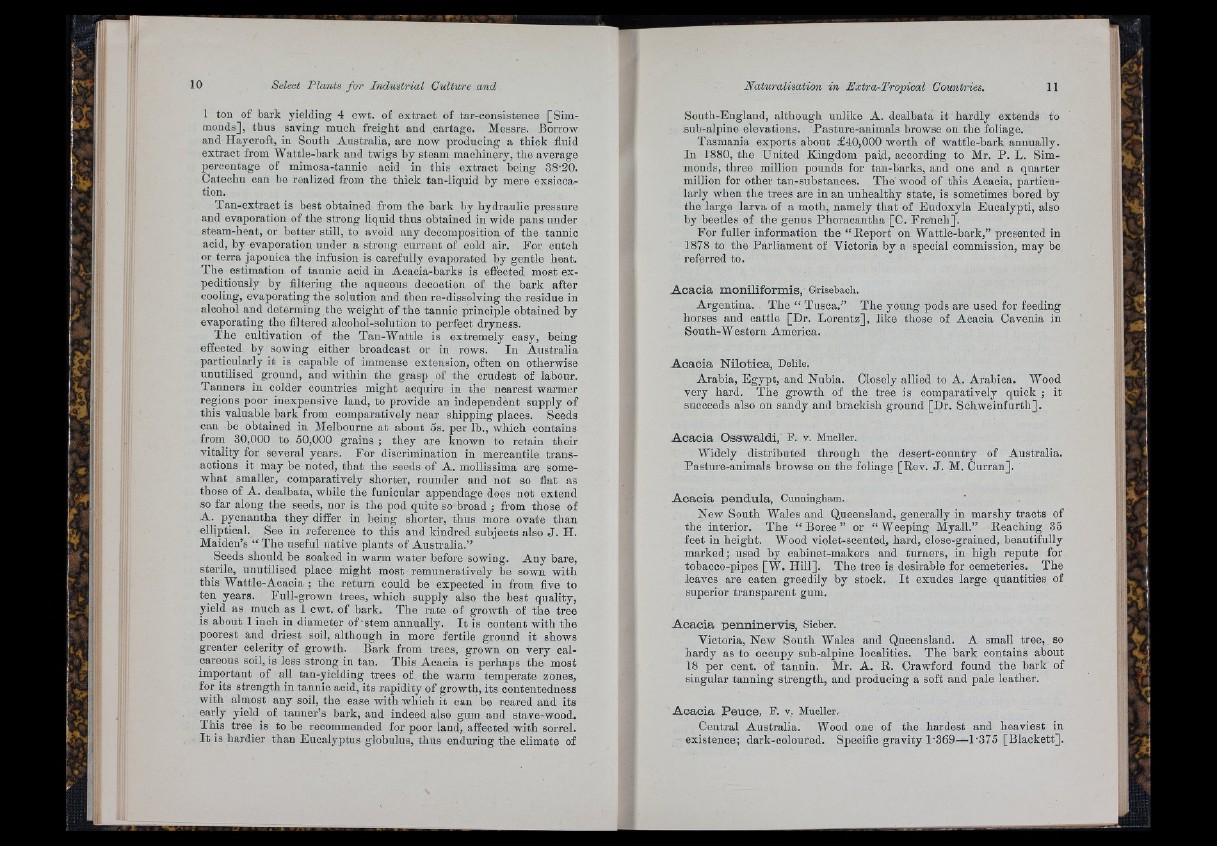
1 ton of bark yielding 4 cwt. of extract of tar-consistence [Simmonds],
thus saving much freight and cartage. Messrs. Borrow
and Haycroft, in South Australia, are now producing a thick fluid
extract from Wattle-bark and twigs by steam machinery, the average
percentage of mimosa-tannic acid in this extract being 38'20.
Catechu can be realized from the thick tan-liquid by mere exsiccation.
Tan-extract is best obtained from the bark by hydraulic pressure
and evaporation of the strong liquid thus obtained in wide pans under
steam-heat, or better still, to avoid any decomposition of the tannic
acid, by evaporation under a strong current of cold air. For cutch
or terra japónica the infusion is carefully evaporated by gentle heat.
The estimation of tannic acid in Acacia-barks is effected most expeditiously
by filtering the aqueous decoction of the bark after
cooling, evaporating the solution and then re-dissolving the residue in
alcohol and determing the weight of the tannic principle obtained by
evaporating the filtered aloohol-solution to perfect dryness.
The cultivation of the Tan-Wattle is extremely easy, being
effected by sowing either broadcast or in rows. In Australia
particularly it is capable of immense extension, often on otherwise
unutilised ground, and within the grasp of the crudest of labour.
Tanners in colder countries might acquire in the nearest warmer
regions poor inexpensive land, to provide an independent supply of
this valuable bark from comparatively near shipping places. Seeds
can be obtained in Melbourne at about 5s. per lb., which contains
from 30,000 to 50,000 grains ; they are known to retain their
vitality for several years. For discrimination in mercantile transactions
it may be noted, th a t the seeds of A. mollissima are somewhat
smaller, comparatively shorter, rounder and not so flat as
those of A. dealbata, wliile the funicular appendage does not extend
so far along the seeds, nor is the pod quite so broad ; from those of
A. pycnantha they differ in being shorter, thus more ovate than
elliptical. See in reference to this and kindred subjects also J . H.
Maiden’s “ The useful native plants of A ustralia.”
Seeds should be soaked in warm water before sowing. Any bare,
sterile, unutilised place might most remuneratively be sown with
this Wattle-Acacia ; the return could be expected in from five to
ten years. Full-grown trees, which supply also the best quality,
yield as much as 1 cwt. of bark. The rate of growth of the tree
is about 1 inch in diameter of stem annually. I t is content with the
poorest and driest soil, although in more fertile ground it shows
greater celerity of growth. Bark from trees, grown on very calcareous
soil, is less strong in tan. This Acacia is perhaps the most
important of all tan-yielding trees of the warm temperate zones,
for its strength in tannic acid, its rapidity of growth, its contentedness
with almost any soil, the ease with which it can be reared and its
early yield of tanner’s bark, and indeed also gum and stave-wood.
This tree is to be recommended for poor land, affected with sorrel.
I t is hardier than Eucalyptus globulus, thus enduring the climate of
Sonth-England, although unlike A. dealbata it hardly extends to
sub-alpine elevations. Pasture-animals browse on the foliage.
Tasmania exports about £40,000 worth of wattle-bark annually.
In 1880, the United Kingdom paid, according to Mr. P . L. Simmonds,
three million pounds for tau-barks, and one and a quarter
million for other tan-substances. The wood of this Acacia, particularly
when the trees are in an unhealthy state, is sometimes bored by
the large larva of a moth, namely that of Eudoxyla Eucalypti, also
by beetles of the genus Phoracantha [C. French],
For fuller information the “ Report on Wattle-bark,” presented in
1878 to the Parliament of Victoria by a special commission, may be
referred to.
A c a c ia m o n ilifo rm is , Grisebach.
Argentina. The “ Tusca.” The young pods are used for feeding
horses and cattle [Dr. Lorentz], like those of Acacia Cavenia in
South-Western America.
A c a c ia N ilo tic a , Delile.
Arabia, Egypt, and Nubia. Closely allied to A. Arabica. Wood
very hard. The growth of the tree is comparatively quick ; it
succeeds also on sandy and brackish ground [Dr. Schweinfurth].
A c a c ia O ssw a ld i, P. v. Mueller.
Widely distributed through the desert-country of Australia.
Pasture-animals browse on the foliage [Rev. J . M. Curran].
A c a c ia p e n d u la , Cunningham.
New South Wales and Queensland, generally in marshy tracts of
the interior. The “ Boree ” or “ Weeping Myall.” Reaching 35
feet in height. Wood violet-scented, hard, close-grained, beautifully
marked; used by cabinet-makers and turners, in high repute for
tobacco-pipes [W. Hill]. The tree is desirable for cemeteries. The
leaves are eaten greedily by stock. I t exudes large quantities of
superior transparent gum.
A c a c ia p e n n in e rv is , Sieber.
Victoria, New South Wales and Queensland. A small tree, so
hardy as to occupy sub-alpine localities. The bark contains about
18 per cent, of tannin. Mr. A. R. Crawford found the bark of
singular tanning strength, and producing a soft and pale leather.
A c a c ia P e u c e , P. V. Mueller.
Central Australia. Wood one of the hardest and heaviest in
existence; dark-coloured. Specific gravity 1‘369—1-375 [Blackett].